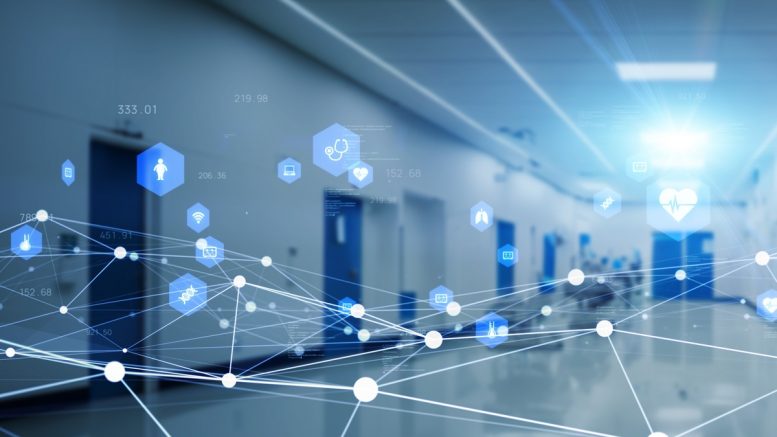In September 2023, the waiting list for hospital treatment approached a record breaking 7.8 million and the 18-week treatment target has not been met since 2016. Labour shortages, aging populations, and playing catch-up from the pandemic all mean the number of clinical and administrative resources available to Trusts are declining while the demand on their services is rising – pushing healthcare providers to the limit.
As the NHS struggles to cope with the backlog of hospital appointments and re-structing on local and national levels, Integrated Care Systems (ICSs) will need robust and comprehensive communication and collaboration services to ensure patients continue to receive the highest level of care and support without service disruption. Integrated and connected communications technology can break down siloed healthcare departments and external organisations to open up new service channels and streamlined workflows that help bridge the growing resource gap.
Solving the healthcare demand crisis with connected communications technology
For patients to receive the care they need, an ICS must ensure they have the resources and capacity to coordinate all healthcare departments and organisations under a unified system. However, according to a recent survey from the National Audit Office only 31% of senior ICS staff considered their ICS to have the capacity to improve illness prevention, a key objective of ICS’s connected healthcare programmes, despite 77% reporting their intention to invest in prevention.
This challenging scenario is entirely feasible as legacy technology systems found in many healthcare organisations often can’t keep up with demand or connect easily between different departments, leading to data siloes and inefficient workflows. To add to these challenges, many healthcare organisations are struggling to keep up with growing demand on their services with the current level of staff they have. This is why modern communications and collaboration services can play a pivotal role in improving workflows, increasing patient access across all care services and helping staff focus on patient-facing services rather than time-consuming administrative tasks thanks to selective and appropriate automation features.
Taking comms beyond cross-departmental boundaries
Today ICS’s face a two-headed challenge, solving workflow pain points within individual organisations while improving Trust-wide communication and collaboration across an entire region. ICSs must enable secure and compliant cross-site communications and collaboration, as well as data sharing for integrated but remote multi-disciplinary teams in both primary, acute, and the wider community care area.
Healthcare providers need to think connected about their communications services to achieve this level of connection. The kind of joined-up communications system that can foster improved collaboration and enable consistent experiences for both patients and staff across multiple groups and organisations requires a powerful communications platform that allows seamless data integration and visibility. By removing silos and complexities from Trust-wide communications and collaboration services, modern communications technologies ensure duplication can be avoided, reducing inefficiencies across staff workloads and improve resource reachability, which in turn reduces wait, diagnosis, and treatment times.
Agility and scalability are the hallmarks of a modern healthcare communications system
As resources are spread ever thinly, healthcare organisations must ensure they are mobilising their resources as efficiently as possible. This requires a solution that is scalable and can adapt workflows to meet seasonal changes in demand, such as peaks during winter, as well as allow resources to be redirected during periods of lower demand.
Digital healthcare services are critical to managing fluctuating service demand. The best communications and collaboration solutions enable Trusts to engage in remote treatments and healthcare monitoring whilst continuing to maintain the quality of care patients would expect while in a hospital. Modern integrated communications achieve this by:
- Providing secure, reliable access to healthcare services over existing, and new, digital communication channels such as video, chatbots, and WhatsApp, offering patients a choice of communication channel that suits them best but always with the option to speak to a person directly if the need arises.
- Offering self-service options to ease the pre-service process by verifying appointments, personal information and documentation, and empowering patients in their healthcare journeys with control over their own healthcare service and data.
- Providing flexible remote working options for healthcare contact centre agents, which will expand the number agents available at any given time to help cope with surges in demand for service.
The aim is to be able to integrate digital healthcare services across a range of departments and devices to create scalable, on-demand services without overwhelming staff. Not only can this provide greater avenues for patient care and service but also offers patients greater flexibility over service interactions, improving both the employee and patient experience.
Automation frees up critical manpower
When staffing shortages threaten to impact the level of patient care, modern integrated communications solutions help ease the administrative burden on both staff and patients that can often get in the way of healthcare access using AI automation. Automating a number of hospital or patient services, such as appointments management, prescription renewals, service payments, and data verification can save time and reduce the need for manual and time-consuming processes. But the automation doesn’t stop at basic tasks. Now intelligent contact centre solutions can automate the triaging process with self-service options and advance AI chatbots to enable patients to speak to the right person faster and enable agents to spend more time on urgent calls.
Not only can automation reduce patient wait times and free up healthcare staff time, it can also improve the accuracy of patient data through the automation data capture.
Enter in the new era of joined up healthcare services
The need for new digital solutions in healthcare management is clear, but in order to achieve the desired outcomes of efficient and seamless workflows, digital transformation must be rolled out in a way that best suits the unique needs of the Trust. Each region has a different population with different healthcare service needs; therefore, a one-size-fits-all approach will not bring the most benefits. Instead, Trusts should take a progressive approach to digital transformation by assessing which areas have the greatest need and then developing from there, with communications and collaboration services as the foundational first steps in their digital evolution.
Find out more about how thinking connected is enabling healthcare providers to streamline essential services, improve employee experiences, and enhance patient care by interconnecting and scaling their systems across multiple regions. Start the journey by benchmarking against industry standards to establish readiness for implementing foundational stepping stones and learn actionable insights and recommendations.
By Dave O’Shaughnessy, healthcare practice leader, Avaya International





